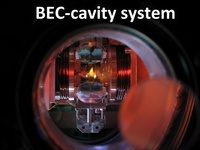Cavity QED with ultracold atomic ensembles in the sub-recoil regime
Hans Keßler, Phatthamon Kongkhambut, Sahana Rao, Andreas Hemmerich
A new exciting aspect of light-matter interactions arises, when large samples of cold atoms are subjected to optical cavities with extreme values of the finesse. In this regime collective long-range forces between distant atoms yield a rich non-linear dynamics. Complex behaviour as self-organization, quantum phase transitions and quantum mechanical squeezing arise in a fully controlled physical environment.
Applications range from quantum information processing to new cavity-based laser cooling mechanisms, which can work for particles with complex internal structure, e.g., molecules. Tailored atom-cavity systems may also be used as efficient analogue simulators for complex many-body systems from other branches of physics.
Introduction

The study of the coupling of single-mode radiation to selected electronic degrees of freedom of single atoms has led to the celebrated field of cavity quantum electrodynamics in the eighties and nineties. In the past decade the focus of research has shifted towards the interaction of a single mode of the radiation field with the external degrees of freedom of well controlled macroscopic objects.
Examples of such objects are sub-micron mechanical oscillators like cantilevers or membranes (which has led to the new field of cavity optomechanics) or, as in this work, droplets of quantum degenerate atomic gases. When quantum ensembles such as atomic Bose-Einstein condensates (BECs) are considered, a unique arena opens up where the worlds of quantum optics and quantum degenerate many-body physics are brought together in order to prepare and study extreme forms of non-linear quantum matter. The fragile nature of ultracold quantum ensembles limits one to dispersive light-matter interactions excluding near resonant excitations followed by spontaneous emission.
We study the most elementary atom-cavity configuration, providing a maximum of control: a BEC of 87Rb-atoms interacting with a single longitudinal mode of a standing wave resonator. The atom-cavity system operates within the intersection of the three regimes of cavity dominated scattering, strong cooperative coupling, and sub-recoil resolution, and hence despite its elementary character it displays unusual behaviour.
